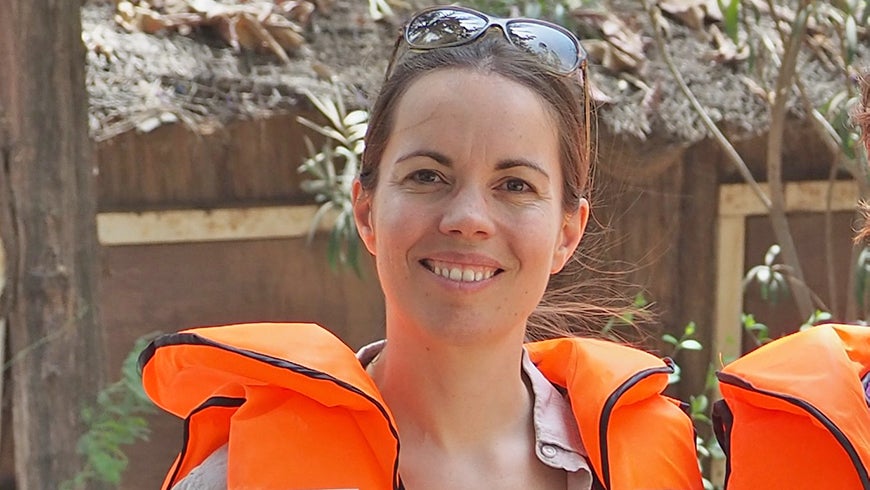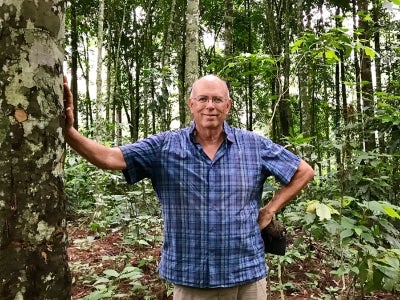
ffem_bouziges_eschmann_55council.jpg
Stéphanie Bouziges-Eschmann is Secretary General of the Fonds Français pour l’Environnement Mondial (FFEM) and serves as France’s Alternate Council Member at the Global Environment Facility. In an interview, she reflected on the connections between biodiversity protection and climate change action and shared insights from France’s decades of experience supporting integrated solutions that prioritize both environmental protection and economic development in partnership with the GEF.
What are the environmental issues of highest concern to your country?
France is concerned with every aspect of the environmental crisis that we face globally but that is particularly affecting developing countries. Biodiversity loss, climate change, land degradation, the state of international waters, and pollution are all inter-linked, and are all sources of great concern to the future of Earth and to mankind. With this vision, France supports the Global Environment Facility and the FFEM, in order to ensure sustainable development in developing countries. This year, our focus is particularly on biodiversity protection and its links to combating climate change – a theme of the One Planet Summit we hosted in January. We are committed to protecting the forests via the National Strategy Against Imported Deforestation and the Tropical Forest Alliance which was established last July with the backing of the French government. France will also host the IUCN World Conservation Congress this September, in Marseilles.
How is the FFEM confronting these issues?
Right from the outset, the FFEM’s mandate spanned both environmental preservation and development, with a strong emphasis on innovation. To respond to these challenges, the FFEM finances small innovative pilot projects and has a particular focus on Africa.
Faced however with the global environmental emergency, we are focused on scaling up solutions that work across multiple geographies. This involves drawing out all the insights from the innovations tested, to identify good practices and to learn from failures. It also requires sharing these good practices and insights with funding or other partners including the GEF to facilitate upscaling or reproducibility. A project’s potential to be scaled is considered right from every project’s conception, and we stay focused on this throughout our project lifecycles. We are also committed to collecting factual and credible data about projects results and communicating these impacts in an effective and strategic way.
Which GEF-supported project is closest to your heart?
The Avaclim project, which is financed by both the GEF and FFEM, is helping seven countries – Burkina Faso, Senegal, Morocco, Ethiopia, South Africa, Brazil, and India – to use agro-ecology to address climate change’s effects in arid areas. While we know that more sustainable, ecologically friendly farming is an important climate adaptation solution, agro-ecology has been poorly resourced in many countries around the world. The Avaclim project is enabling countries to address a number of environmental challenges simultaneously: adaptation to climate change, soil degradation, pollution by pesticides and chemical inputs, and loss of biodiversity. Drawing upon best practices from countries that have faced similar difficulties, the project is allowing the effectiveness of agro-ecology to be demonstrated in particularly vulnerable areas. As a “research-action” project based in science, it encourages knowledge sharing and awareness-raising while also including advocacy actions intended for decision-makers.

Stéphanie Bouziges-Eschmann on a project visit
How has COVID-19 affected your work?
Globally in areas where both the FFEM and GEF are active, we’ve seen that the health and economic crisis has hindered sustainable development. It has given rise to new pressures on natural resources and biodiversity. During the lockdown, protected areas have been less well monitored and people's income has fallen, resulting in a resurgence of poaching and consumption of less sustainable bush meat. The limiting of movement has hindered pastoral migration in some regions, leading to overgrazing and soil degradation.
We are also seeing project deployment being slowed by funding constraints. Faced with such uncertainty, some investors are holding onto their money. There are also problems with the supply of equipment and with the closure of local and international markets, resulting in hampered project delivery and raising the specter of lost income for many people. However, by listening to the beneficiaries we've been able to adapt. Some activities have been scaled back or developed, their timescales revised, geographical scope modified, new activities proposed, or top-up financing granted in some cases.
In that regard, the GEF and the FFEM have maintained close relationships with implementing agencies and beneficiaries and have been able to pursue all their activities remotely – even with virtual board meetings allowing for the financing to be committed to the projects on time.
How can the world better-respond to such crises in future?
We need to ask ourselves serious questions about new challenges in a world transformed by the crisis.
For 25 years the FFEM has been working alongside the GEF to prevent some of the identified causes of the pandemic, whether through the One Health approach, nature-based solutions, or the circular economy. We have been able to deliver paths to a sustainable recovery through this integrated approach. But the COVID-19 crisis is pushing us to search for an ever-wider transformational impact.
This will be achieved through stronger collaboration with local stakeholders and enhanced efforts to empower them. We also need to further build on our integrated approach to environmental issues – from climate change to biodiversity, land degradation, pollution, and more – while re-affirming our focus on working to achieve the Sustainable Development Goals through each project. Looking ahead we will need to keep working in a systematic way that runs through societies, lifestyles, economic activities, and public policy. The discussions starting on GEF-8 replenishment will need to include an emphasis on these aspects to ensure we offer lasting solutions to build back better and greener.
What environmental changes do you hope to see by the time you retire?
I dream of a new world 25 years from now: a world in which governments, firms, and people are aware and consider their impact on the environment, and the relationship between environment and health. The circular economy finds frequent application here, with no more pollutants used, no more waste not properly recycled and dealt with, no more unnecessary use of plastics; one-third of Planet Earth is protected, with major ecosystems preserved while the remainder is sustainably inhabited; resilient cities build nature into their planning; the energy transition applies across all sectors including power generation, transport, building management, and industries; agro-ecological practices are widely employed; deforestation is halted and forest restoration is happening; glaciers and the ice shelf are no longer shrinking; the permafrost is stable; and scientific innovation has permitted cleaning of the oceans on a massive scale. Carbon emissions are no longer out of control. Biodiversity loss and the Earth’s temperature rise have finally been brought under control. Making this dream reality requires major steps to be taken now, in our decisions and in our behavior, at every level.


